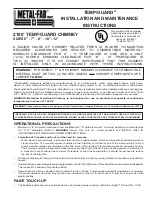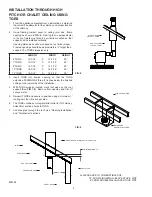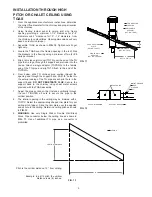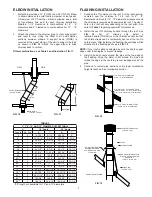
6
MASONARY FIREPLACE CHIMNEY,
AND CHIMNEY EXTENSION
An anchor plate (TGAP) is used to attach Metal-Fab Temp/
Guard Chimney to a masonry fireplace or chimney. Maximum
support height of 60 ft.
1. Where the transition is to be made, apply a bed of mortar
approximately 3/4 inches deep and approximately one
(1) inch larger than the anchor plate. (See TG Chimney
Catalog for anchor plate dimensions).
2. Insert four (4) 1/4-20 x 2” anchor bolts, head down into the
mortar bed. J-style anchor bolts are preferred. An alternate
method would be to allow the mortar bed to cure. Then, drill
four (4) holes, matching the holes in the anchor plate and
insert four (4) each 1/4-20 metal anchors. The anchor plate
would then be attached by four (4) each 1/4-20 bolts.
3. Before the mortar sets, place the anchor plate over the bolts
and press down into the mortar. Loosely secure using a
washer and nut on each bolt.
4. Use a level to check the installation, assuring that the TG
chimney connection (TGAP) is level.
5. When the mortar has set up, tighten the nuts onto the bolts.
Proceed to stack Metal-Fab chimney pipe (TG) on the
anchor plate.
6. See “Flashing Instructions” and “Termination” sections.
NOTE:
Existing masonry flues may be extended with TG pipe
by using an anchor plate, following steps 1 through 7 above,
provided that:
a) The existing masonry chimney is structurally sound,
and;
b) The flue extension is properly sized so that the
appliance attached to the flue drafts properly.
NOTE:
The TG flue size for a height less than 15 feet should be
at least 1/8 the area of the fireplace opening. The TG flue size
for a height over 15 feet should be at least 1/10 the area of the
fireplace opening. (For sizing of TG flue, See Metal-Fab literature
L1372.)
EXAMPLE:
A fireplace opening of 22” x 34” has an area of
(748 in
2
) with a chimney height less than 15 feet, the effective
area is 1/8 x (748 in
2
) = 93.5 in
2
. Closest flue diameter size = 10”.
With a chimney height over 15 Feet, the effective area is 1/10 x
(748 in
2
)=74.8 in
2
. closest flue diameter size = 10”.
ANCHOR
EMBEDDED
IN MORTAR
L944 FIG15A
NOTE:
ANCHOR PLATE MOUNTED
AT MASONRY FIREPLACE
FLUE OPENING AREA
WITH, BOLT, NUTS, AND
WASHERS
ANCHOR PLATE
(CAT. NO. TGAP)
BED
OF MORTAR
FIG. 14
FIG. 15








